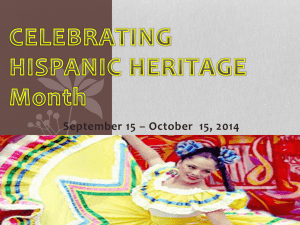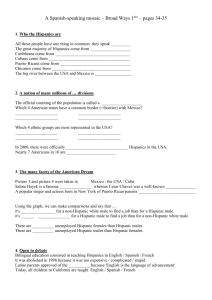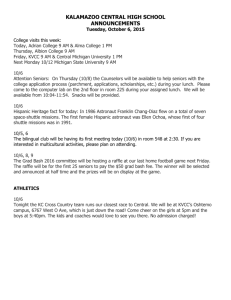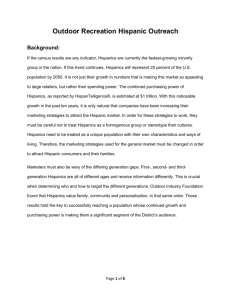Hispanic Culture
advertisement
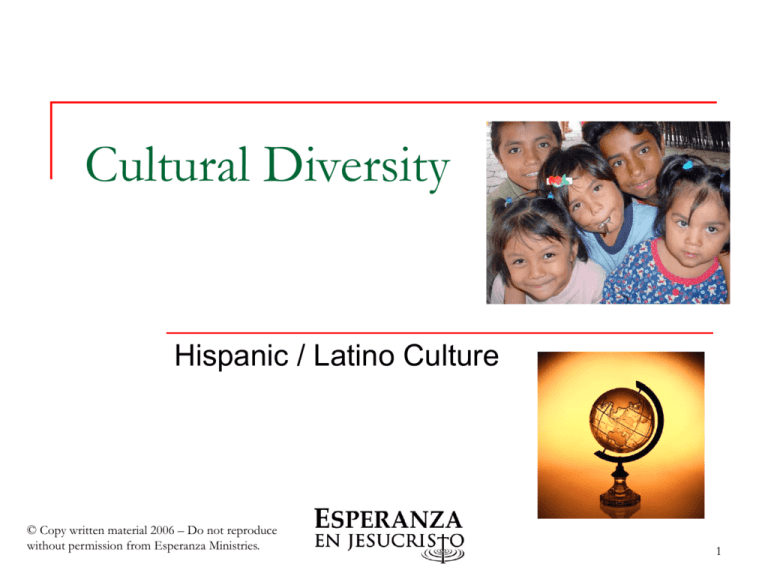
Cultural Diversity Hispanic / Latino Culture © Copy written material 2006 – Do not reproduce without permission from Esperanza Ministries. 1 Who are the Hispanics? Foreign nationals from: © Copy written 2006 2 Who are the Hispanics? Foreign nationals from: Central America Mexico Belize Guatemala Costa Rica Nicaragua Honduras El Salvador Panama Other Islands surrounding continent © Copy written 2006 South America Columbia Brazil Argentina Peru Caribbean Puerto Rico Cuba Jamaica Dominican Republic Other Islands in Caribbean Sea 3 Nomenclature Mexican-American = those who are second generation Hispanic citizens of the United States Hispanics = refers collectively to all Spanish Speakers, typically descendents of Spain Latino = refers to those that come from Latin America, with some romance language. Mexican = refers to all who are of Mexican citizens © Copy written 2006 4 Why they are here? Economics Countries of origin are in extreme poverty. United States offers higher wages even when paid minimum wage. Indiana is conservative and has a large restaurant industry. Johnson County offers good schools and a welcoming community. © Copy written 2006 Future of children School in their countries are unreliable, ill equipped and understaffed. School in the mountains where most normally only go as far as elementary. Most children begin working at an early age to help with family expenses. Chances for a country child to have a future is slim. 5 How they get here? One village man will be sent to the U.S.A This person works multiple jobs to send money to get others the means to come here. Family members come one at time via someone who is paid to get them here safely ($2,000 to 3,000 a person.) One by one they all arrive to work hard to send money for the next family in the village. © Copy written 2006 6 Their Goal Learn English Get educated Earn money to help others in village Help their children have a future. To live with integrity and honor. They would rather be illegal, living with some dignity than have to steal to feed their children. © Copy written 2006 7 Meeting Etiquette When greeting in social situations, women pat each other on the right forearm or shoulder, rather than shake hands Men shake hands until they know someone well, at which time they progress to the more traditional hug and back slapping. Wait until invited before using a Hispanics first name. © Copy written 2006 8 Hierarchical Society Hispanic society and business are highly stratified and vertically structured. Hispanics emphasize hierarchical relationships. People respect authority and look to those above them for guidance and decision-making. Rank is important, and those above you in rank must always be treated with respect. © Copy written 2006 9 Hierarchical Society (cont.) This makes it important to know which person is in charge, and leads to an authoritarian approach to decision-making and problemsolving. Health decisions for the family members is made by this person. Typically the father. Hispanics are very aware of how each individual fits into each hierarchy--be it family, friends or business. It would be disrespectful to break the chain of hierarchy. © Copy written 2006 10 Machismo Machismo literally means 'masculinity'. There are different outward behaviors to display machismo. For example, making remarks to women is a stereotypical sign of machismo and should not be seen as harassment. Hispanic males generally believe that nothing must be allowed to tarnish their image as a man. © Copy written 2006 11 Relationship Hispanics are warm and gracious. They have an embrace the morning attitude, and do not embrace the time-is-money mentality of many other cultures. The old Mexican saying is that "North Americans live to work, but Mexicans work to live!" Time is NOT as relevant as relationship. They usually will not cut a visit short because of time. © Copy written 2006 12 More on Relationship Most of them will live in the moment rather than the past or future. If your natural tendency is to speak quickly or you have a forceful or sharp tone of voice, become aware of how you are coming across. © Copy written 2006 They become sensitive to the pace and tone used it should be steady, respectful and grace filled. 13 Family Values The family is at the center of the social structure, they are close knit group and the individual is never as important as the whole. Most of Johnson county Hispanics come from remote areas of their countries. Outside of the major cosmopolitan cities, families are still generally large. © Copy written 2006 The extended family is as important as the nuclear family since it provides a sense of stability. Usually the older women care for the grandchildren, so living skills develop later in life. 14 More on Family Values Hispanics consider it their duty and responsibility to help family members. For example, the will help find employment or finance a house or other large purchase. Most Hispanic families are extremely traditional, with the father as the head, the authority figure and the decision-maker. Mothers are greatly revered, but their role may be seen as secondary to that of their husband. © Copy written 2006 15 Nuclear Family © Copy written 2006 Hispanics can be classified as familyoriented. They tend to be patriarchal (male dominated). Roles within the family are assigned on the basis of gender and position. Older members of the family carry a great deal of authority. Usually the mother’s role is to discipline the children while the father’s role is to be responsible for establishing the standards of behavior. Children’s role vary with gender and age. The oldest female takes care of the youngest; oldest male does the same, and takes the role of parents if parents pass away. Grandparents or elders are highly respected. 16 Communication Standing with your hands on your hips suggests aggressiveness, and keeping your hands in your pockets is impolite. Hispanics may not make eye contact. This is a sign of respect and should not be taken as an affront. Men shake hands upon meeting and leaving, and will wait for a woman to be the first to offer her hand. Women may shake hands with men and other women. Many times a woman may pat another woman's shoulder or forearm, or kiss on the cheek. Longtime friends may embrace, and after several meetings you may also be greeted with an embrace. Punctuality is not rigid because of the emphasis on personal obligations. © Copy written 2006 17 More on Communication Appointments are not typical, usually they come to a clinic or school and wait all day to be seen. Conversations take place at a close physical distance. Stepping back may be regarded as unfriendly. Hispanic men are warm and friendly, and make a lot of physical contact. They often touch shoulders or hold another’s arm. To withdraw from this touch is considered insulting. © Copy written 2006 18 More on Communication Refrain from using first names until invited to do so. Hispanics generally use two surnames. The first surname listed is from the father, and the second surname listed is from the mother. When speaking to someone use his or her father’s surname. © Copy written 2006 19 Eating Habits In Hispanic countries, a light meal is served for breakfast. Lunch, referred as el almuerzo, usually is the main meal of the day for Spanish-speakers. In some countries, it is customary for adult family members and children to come home from work or school for about two hours to be together for this meal. In the early evening, la merienda, a light snack of coffee and rolls or sandwiches, is served. This meal is often very informal and may be just for children. In the evening, often as late as 9:00 p.m., la cena, a small supper, concludes the day's meals. © Copy written 2006 20 Eating Habits (cont) Once settled in the United States, most Hispanics adopt the three-meal system. Midday and evening meals are important family or social events. Especially when guests are present, the meal may be followed by the sobremesa, a time to linger and talk over coffee or perhaps an after-dinner drink. Usually when food or additional servings are offered to Hispanics, they tend to accept only after it is offered a second or third time. © Copy written 2006 21 Health Hispanic’s view good physical and mental health as having a balance with God and a congruence or harmony with the family, other persons, and the customs of the church. In order for the American therapist to treat a Hispanic successfully, there must be a style that is comfortable and acceptable to Hispanic’s. Many of the ingredients used by folk healers must be taken into consideration. © Copy written 2006 22 Folk Medicine People tend to look for reasons for why they become ill. Beliefs are that the imbalance between hot and cold cause illnesses. Cold disease – cured with hot remedies (teas) Menstrual cramps Pneumonia Colic Hot diseases – cured with cold remedies (cold drinks) Pregnancy Hypertension Diabetes Acid indigestion © Copy written 2006 23 More on Health Understanding the cultural knowledge and attention to the behavioral implications of respect, personalizing, and conversing is necessary when dealing with this population. The therapist needs to accept and understand the importance of familism and church, as well as the meaning of the client’s relationship to these cultural entities. If traditions, beliefs and culture are ignored it will be difficult to establish confianza en confianza (trust in trust) that exists between the Latino community and with traditional healers © Copy written 2006 24 Anxiety © Copy written 2006 Entry trauma is found common for many of the Hispanics in Johnson county. This is due to manner by which they enter the country. Nerviosidad may describe nervousness but to a Nica (Nicaraguans often refer to themselves as a Nica), it describes being traumatized and panic attacks. 25 School Most of the countries in central America have unregulated public education. All schools in the country are not alike, nor are they teaching similar material. © Copy written 2006 If a teacher is absent there are no substitutes and the children would not attend school on that day 26 School (cont.) Parents respect the teachers a great deal and will do anything the teachers ask of them. Most schools are corrupt in that they need to purchase materials from the school and they often pay too much for the materials. Parents are usually not involved in any of the decisions about the child’s education. © Copy written 2006 27
